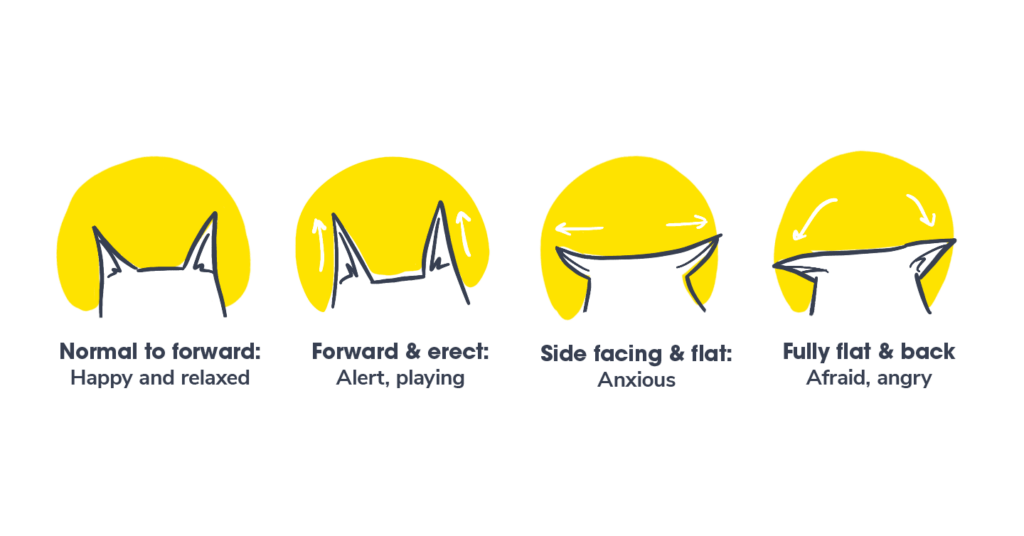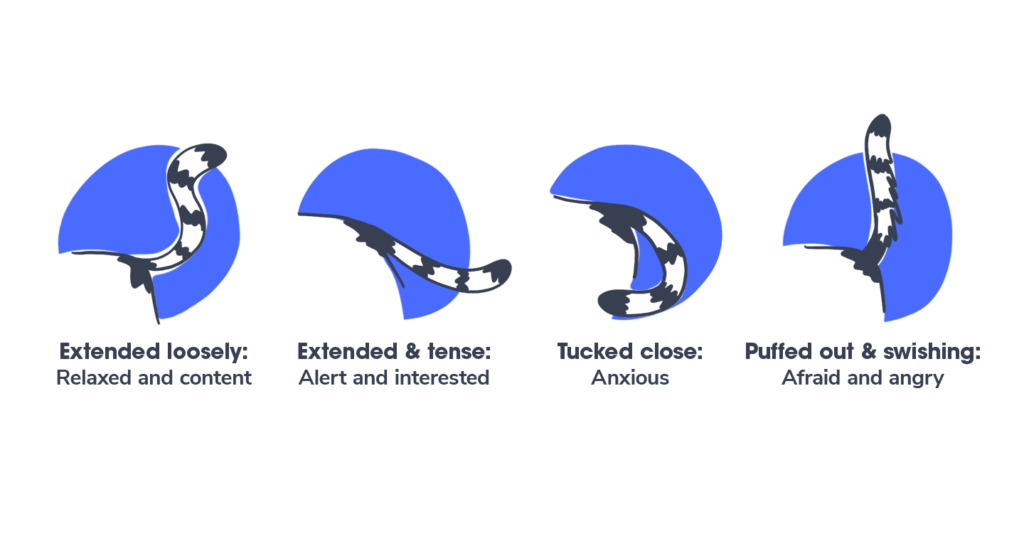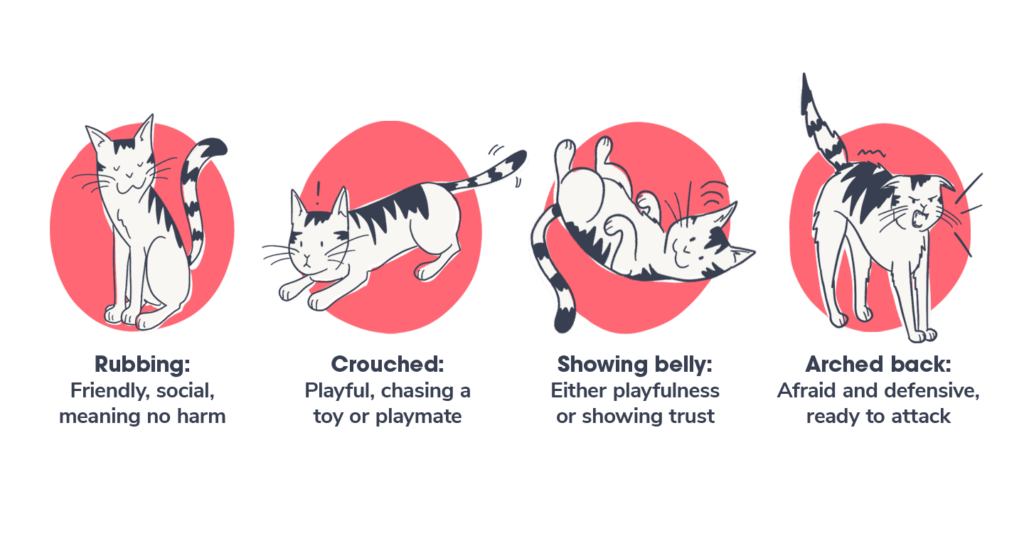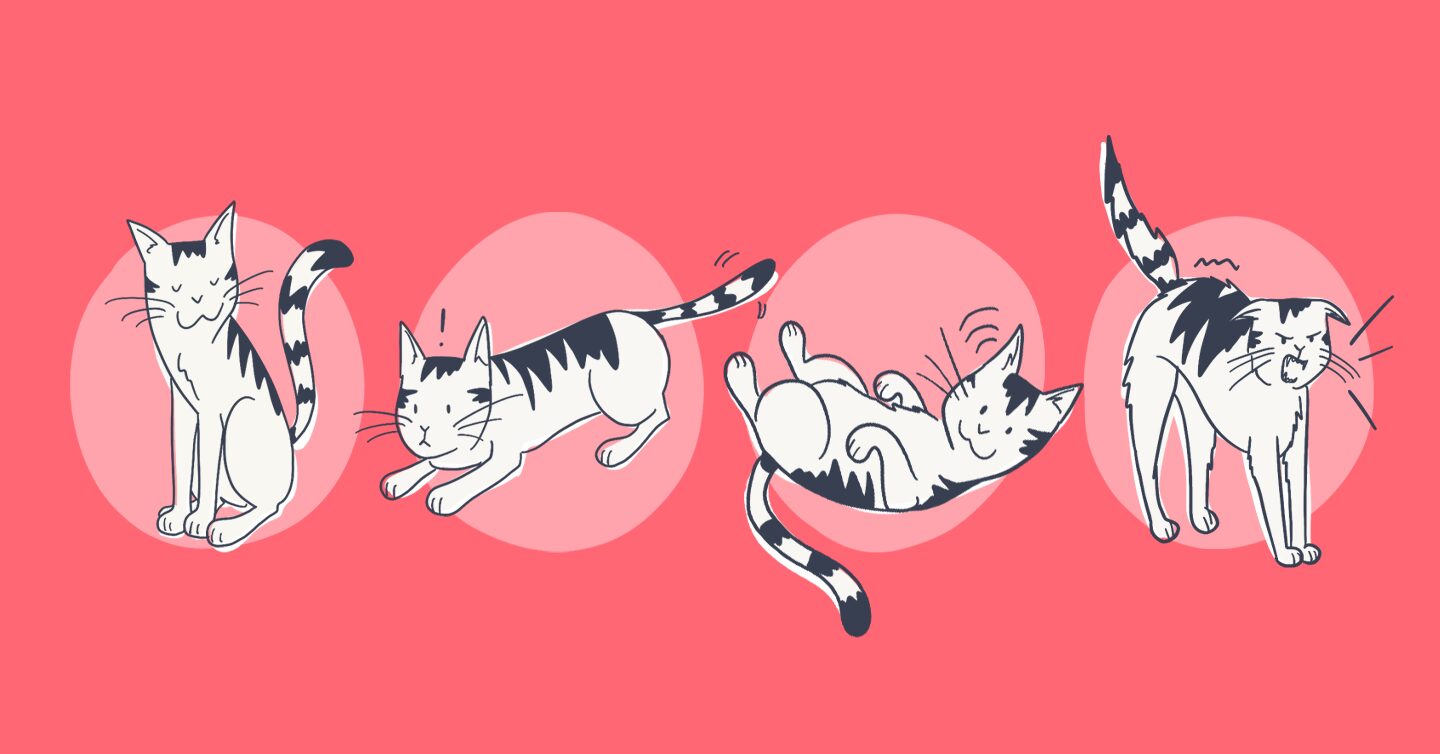Talking animals are the stuff of fairy tales and fiction. But as a cat owner, you’d probably love to be able to speak with your cat. If you pay attention to body language, though, you know your cat already talks to you every day – through postures, gestures, and vocalizations.
Fortunately for you, learning to read your cat’s body language isn’t as complex as you might think. In fact, it’s key to successfully communicating with your favorite feline friend. Here, we’ll review the different ways that cats use their bodies (and voices!) to communicate – and how to understand those behaviors.
You’ll be speaking “cat” in no time!
Understanding Cat Body Language
According to the American College of Veterinary Behaviorists, cats typically convey information with their bodies through a combination of redundant signals. Different parts of the cat’s body, like their tail, ears, or eyes, provide cues that express important messages.
In order to read a cat’s body language, therefore, you need to look at each individual signal – as well as the cat’s behavior as a whole – to evaluate what they’re trying to say.
Below, we’ll break down some common signals you might see, as well as some of the most well-known postures, gestures, and vocalizations – and what they usually mean.
Ears

Cats have 32 muscles in each ear – compare that to six in each human ear – which means those ears can say a lot. Here some of the signals you might see, based on the position of your cat’s ears:
- Normal to forward: Your cat is happy and relaxed. Your cat’s ears might look like this if your feline friend is lounging on their favorite spot on the couch.
- Forward and erect: Your cat is alert. You might see their ears in this position when your cat is playing – when, for example, they’re preparing to pounce on a toy.
- Partially flattened, turned to the sides: Your cat is anxious. Your cat’s ears might look like this during a vet visit.
- Fully flattened: Your cat is afraid. Your vacuum or a sudden loud noise might trigger this reaction.
- Fully flattened, back on head: Your cat is defensive and ready to act against a perceived threat. You might see these ears when your cat is extremely angry.
Eyes
What do your cat’s eyes have to say about their mood? Here are a few things to look out for:
- Normal pupils: Your cat is happy, relaxed, or alert. If your cat’s eyes are slightly closed – or they slowly blink at you – this indicates your cat is very relaxed. Slow blinks are a sign of total relaxation and trust with you. If your cat is more alert, their pupils will be normal, but their eyes will be more open.
- Enlarged pupils: If your cat’s pupils are enlarged, they may be tense and anxious. These pupils may accompany partially flattened ears, indicating that your cat is nervous about something.
- Dilated pupils: Dilated pupils mean your cat is fearful. They may be planning to exit the situation and hide, or they may be defensive and preparing to attack.
Whiskers
Cats use their whiskers to help them navigate their environment. Although these sensory tools allow cats to evaluate their surroundings, they don’t reveal too much about their behaviors or moods.
In general, whiskers can tell us two things, according to their position:
- Normal to forward: Normal to forward whiskers can mean a cat is relaxed and happy, but they could also mean a cat is playful and alert. Typically, the more forward the whiskers, the more alert the cat.
- Back and flat against the face: When a cat has their whiskers pulled back against their face, it signals anxiety and fear. Normally, the farther back their whiskers are pulled, the angrier the cat.
Tail

You can learn a lot about a cat’s mood from their tail. Like their ears, their tail plays a large role in helping you evaluate their body language. Here are some common signals, based on the tail’s position:
- Out behind or over the back: If your cat’s tail is extended loosely – whether it’s lying flat or standing up – this usually means your cat is relaxed and content. Happy cats may also curl their tails into a question mark shape.
- Tail tense, upright or down: An extended tail, held upright or down, can signal that your cat is interested and alert. Your cat may display this tail signal when playing. You might even see their tail twitch a little bit – if, for example, your cat is crouching and ready to pounce.
- Close to the body, curled forward, or tucked away: This body language usually suggests that a cat is anxious. In this case, cats try to make themselves smaller and tuck their tails close to their bodies. This indicates a cat wants to be left alone.
- Curled close to the body, puffed out, swishing or lashing: This type of cat’s tail shows fear and anger. This type of tail signal usually comes as the result of a perceived threat – and the swishing or puffed out tail might suggest that the cat will attack, especially if accompanied with hissing.
Postures and Gestures

Now that you know a bit more about the signals your cat is sending, let’s review some common postures and gestures and what they indicate about your cat’s mood or behavior.
- Rubbing: This is a friendly posture that cats use to greet new cats and new people. Rubbing is a type of social interaction that shows they mean no harm. Additionally, when a cat rubs their chin, for example, they transfer their facial pheromones onto you, or another cat. This is a form of scent marking.
- Showing their bellies: When a cat shows their belly, we can interpret it in two slightly different ways. Sometimes, cats show their bellies to indicate playfulness, whether with other cats or with humans. A cat may show their belly and then grab your hand when you go in to touch it. At other times, though, cats show their bellies to signal relaxation and trust. Not all cats are fond of belly rubs, but many love to receive them.
- Licking: This is an interesting gesture, because there are a variety of reasons why your cat may lick you. Some cats lick you to show affection or to claim you as their territory, while others lick you as a reaction to anxiety or stress. Other cats do it to get your attention, or simply because they think you need to be groomed.
- Crouched: A crouched position indicates that your cat is in a playful mood. This position mimics a predator chasing their prey – you might see your cat crouched down while chasing after toys, or even while preparing to pounce on a playmate. You might also see your cat flicking his tail in this position, or even chirping excitedly.
- Kneading: Most often, kneading is a sign of a sleepy, relaxed, or happy cat. Kneading is a feline behavior that starts in kittenhood, and adult cats tend to exhibit this gesture when they’re preparing for a nap, or when they’re feeling content.
- Arched back: This posture is a sign that you should stay away from your cat. A cat with an arched back is afraid and defensive. In some scenarios, cats will move low to the ground to defend themselves. This posture – combined with an arched back – indicates an aggressive cat that may be getting ready to attack.
Interpreting Cat Vocalizations
To communicate with your cat, you’ll want to understand vocalizations – purring, chirping, hissing, meowing – in addition to identifying body signals and learning what they mean. Vocalizations often accompany particular bodily signals. They can help provide insights into your cat’s body language.
Here are some common cat vocalizations, as well as what you can learn from them:
- Purring: A purr is usually a sign of a happy cat. Your cat may purr when they’re lounging around, relaxed, and content. Some cats also purr as a self-soothing or healing mechanism when they’re hungry, stressed, or injured.
- Meowing: There are many different types of meows. A cat might meow during playtime – these vocalizations may sound like chirps or churrs. Your cat may chirp when they’re interested in something, like a bird or a squirrel outside your window. Additionally, a cat might meow at you to get your attention, to indicate they’re hungry, or to show they’re annoyed. Interestingly enough, however, cats don’t usually meow at other adult cats, preferring to meow humans. So if your cat is meowing, they’re probably talking to you.
- Yowling: A yowl is similar to a meow, but it’s more drawn out and can sound a little like a howl. Adult cats that are mating tend to yowl during breeding season. If your cat isn’t looking for a mate, they still might yowl if they’re anxious, or just want to be demanding.
- Hissing and growling: You’ll only hear these sounds from a very angry and fearful cat. A cat with an arched back and lashing tail might also be hissing and growling, and possibly even spitting if they’re feeling particularly threatened.
How to Communicate With Your Cat
Whether you’re looking to understand your favorite feline or thinking about getting a new cat for your family, it’s always helpful to learn about the best ways to communicate with them. Learning how to read your cat’s body language and respecting the signals they’re showing is the first step.
If your cat is laying on a chair and they shift their ears down a bit to the sides as you approach, this could mean they want to be left alone. Since you now understand the message your cat is sending, you may decide another time is better for some snuggles.That said, though you’re probably not going to be able to teach your cat to respond to verbal cues the same way your dog does, research shows that cats can understand their own names, so there’s no reason you can’t continue to talk to them. And if your cat talks back, you can now interpret what they’re saying for some insight into what they’re feeling.




